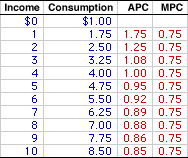
|
|
MARGINAL FACTOR COST CURVE, PERFECT COMPETITION: A curve that graphically represents the relation between marginal factor cost incurred by a perfectly competitive firm for hiring an input and the quantity of input employed. A profit-maximizing perfectly competitive firm hires the quantity of input found at the intersection of the marginal factor cost curve and marginal revenue product curve. The marginal factor cost curve for a perfectly competitive firm with no market control is horizontal.
Visit the GLOSS*arama
|
|


|

|
                           CONSUMPTION SCHEDULE: A table or chart that represents the relation between household sector consumption and income. A consumption schedule is commonly used for a basic, instructional presentation of aggregate consumption activity by the household sector and is also used as a source of numbers for deriving the consumption line. The key measures derived from the consumption-income relation in the schedule are average propensity to consume and marginal propensity to consume. The saving schedule is comparable table for the relation between saving and income. A consumption schedule is table of numbers showing the relation between consumption expenditures and income for the household sector. The income measure commonly used is national income or disposable income. Occasionally a measure of aggregate production, such as gross domestic product, is used instead.The purpose of a consumption schedule is to summarize the basic consumption-income relation for the household sector, which provides a means of deriving the consumption line. The consumption line is the foundation of the aggregate expenditures line used in Keynesian economics. Two important measures of consumption that are usually presented in a consumption schedule are average propensity to consume (APC) and marginal propensity to consume (MPC). APC is the average consumption at each level of income and MPC is the change in consumption resulting from a change in income. | Consumption Schedule |  |
A representative consumption schedule is presented in the exhibit to the right. The four columns in the table measure income, consumption, average propensity to consume (APC), and marginal propensity to consume (MPC). Income and consumption are measure in trillions of dollars.The first column of this table presents total income of the household sector. These values conveniently range from $0 to $10 trillion. The second column then presents the amount of this income the household sector uses for consumption expenditures. These values range from $1 trillion to $8.5 trillion. The third column is then the average propensity to consume (APC), ranging from a high of 1.75 to a low of 0.85. Finally, the fourth column presents the marginal propensity to consume (MPC), which remains constant at 0.75. The consumption schedule summarizes important information about the consumption-income relation. - One, as income increases from $0 to $10 trillion, consumption increase from $1 trillion to $8.5 trillion. This illustrates induced consumption and the consumption-income relation. This relation is also captured graphically in a positively-slope consumption line.
- Two, income increases at a faster rate than consumption. This is captured by the MPC in the fourth column and results from the psychological law of Keynesian economics. The MPC in the fourth column is the change in consumption in the second column divided by the change in income in the first column. In this schedule, the MPC is constant at 0.75. While the MPC need not be constant over the entire range of income, it is often assumed to be for the sake of simplifying an analysis. The MPC is also the slope of the consumption line.
- Three, income and consumption are only equal at $4 trillion. Consumption is greater than income at lower levels and less than income at higher levels. Saving, the difference between income and consumption, is not explicitly shown in the table, but it can be identified nonetheless. For example, at $4 trillion, income and consumption are equal, meaning saving is zero. If income is greater than consumption, then saving is positive. If income is less than consumption, then saving is negative.
- Four, the $1 trillion of consumption undertaken when income is $0 is autonomous consumption. Autonomous consumption also shows up as the intercept of the consumption line.
- Five, the APC is presented in the third column. This is simply average consumption at each level of income or consumption divided by income. Unlike the MPC, the APC is not constant, but differs from one income level to the next.
- Six, the amount of income and consumption undertaken at full employment is not indicated by this table. In fact, full employment is largely irrelevant to this table, which is an essential point underlying Keynesian economics.

Recommended Citation:CONSUMPTION SCHEDULE, AmosWEB Encyclonomic WEB*pedia, http://www.AmosWEB.com, AmosWEB LLC, 2000-2024. [Accessed: April 28, 2024].
Check Out These Related Terms... | | | | | | | | | | | | |
Or For A Little Background... | | | | | | | | |
And For Further Study... | | | | | | | | | | | | | | |
Search Again?
Back to the WEB*pedia
|



|

|
RED AGGRESSERINE
[What's This?]
Today, you are likely to spend a great deal of time searching for rummage sales hoping to buy either several magazines on time travel or 500 feet of telephone cable. Be on the lookout for bottles of barbeque sauce that act TOO innocent.
Your Complete Scope
This isn't me! What am I?
|

|
|
Approximately three-fourths of the U.S. paper currency in circular contains traces of cocaine.
|

|
|
"The roots of education are bitter, but the fruit is sweet." -- Aristotle
|

|
GMM
Generalized Method of Moments
|

|
|
Tell us what you think about AmosWEB. Like what you see? Have suggestions for improvements? Let us know. Click the User Feedback link.
User Feedback
|


|


